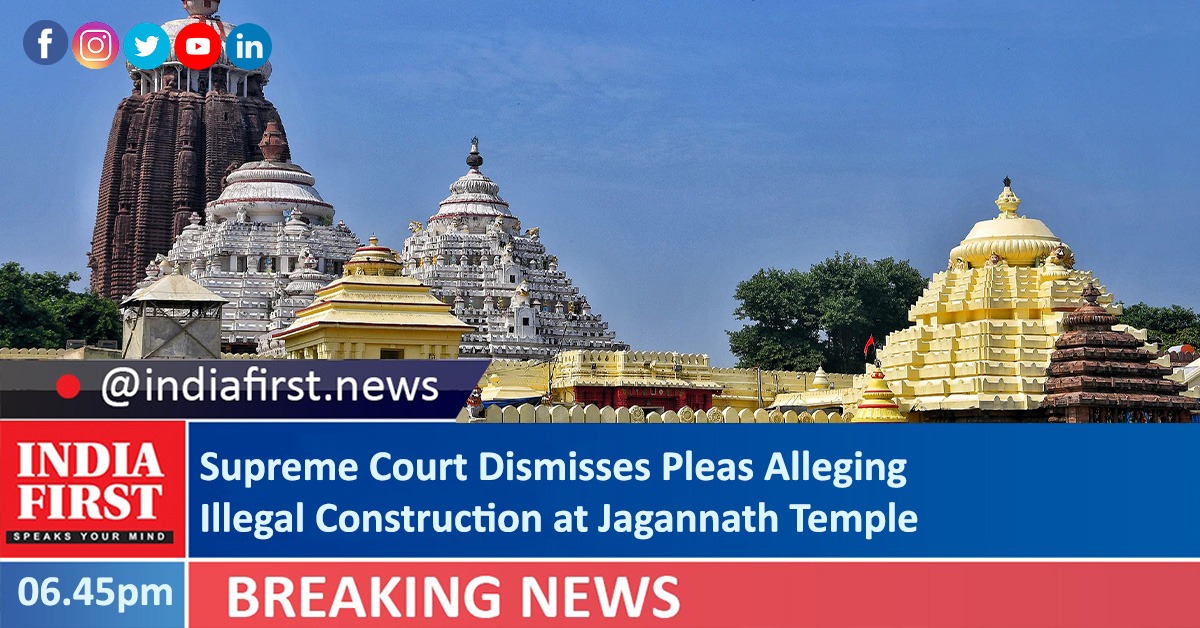The Supreme Court has imposed a fine of Rs one lakh while junking petitions that alleged illegal constructions and excavation at Shree Jagannath temple in Puri by the Odisha government, saying the petitioners unnecessarily made a hue and cry.
The court said the public amenities activities carried out by the state government were in larger public interest.
A vacation bench comprising Justices B.R. Gavai and Hima Kohli said the petitioners made a hue and cry as if heavens would fall if the petitions were not listed.
The bench said: “In the recent past, it is noticed that there is a mushroom growth of public interest litigations. However, in many of such petitions, there is no public interest involved at all. The petitions are either publicity interest litigations or personal interest litigation.”
The bench said a hue and cry was made that the construction carried out is contrary to the inspection report carried out by the Archaeological Survey of India. “However, the note of the Director General of ASI dated February 21, 2022 as well as the affidavit filed by the ASI before the High Court would falsify this position,” said the bench in its 40-page order.
The top court strongly objected to the filing of frivolous petitions, and termed it “abuse of process of law”.
The bench added, “It is high time that such so-called public interest litigations are nipped in the bud so that the developmental activities in the larger public interest are not stalled”.
The top court imposed Rs one lakh cost on each petitioner payable to the Odisha government within four weeks.
The bench said the affidavit of the superintending archaeologist, ASI revealed that there does not appear to be any serious objection with regard to construction of works such as toilets, drains, and electrical works in the prohibited area. It added that there also does not appear to be any serious objection with regard to undertaking construction in the regulated area.
During the hearing, the court was told that every day, at least 60,000 people visited the temple and toilets and other facilities were required. It was also pointed out that during the annual Rath Yatra, around 15-20 lakh people visited the temple.
The bench said: “If an individual person can construct a toilet in a prohibited area; can the State be denied to do so, when the State finds it necessary to do it in the larger public interest for providing basic facilities to the lakhs of devotees visiting the shrine? The answer is an emphatic ‘no’.”
The bench said it has no hesitation in holding that the activities undertaken by the state government are completely in tune with the directions issued by the three-judge bench of the apex court in the case of Mrinalini Padhi. “They are necessary in the larger public interest and there is no prohibition in the statute for doing so, as sought to be argued by the appellants”, it added.
The bench cited the statement made by the Advocate General for Odisha government before the high court that both the ASI and the government would work together to ensure that no archaeological remains are missed out or damaged.
“It was further observed that the ASI would work in coordination with the state government on the design so that there is no visual impact on the main temple. The state government was also requested to keep the entire design simple in tandem with the spiritual nature of the entire temple complex,” said the bench.
During the hearing senior advocate Mahalakshmi Pavani, representing one of the petitioners, submitted that no construction can be carried out in the prohibited area at the temple and the state government got the NOC from the National Monuments Authority (NMA) and carried out the construction. She argued that only director archaeology, either at the Central or state level, could grant a valid certificate, and not the NMA.
Advocate General (AG) for Odisha Ashok Kumar Parija contended before the bench that NMA is the authority under the Ancient Monuments and Archaeological Sites and Remains Act, 1958. He added that the state government’s director culture is the competent authority, which gave the permission, and the government plans to provide amenities and beautification of the temple.
The petitioners, Ardhendu Kumar Das and others, challenged validity of the high court’s order of May 9 refusing to intervene with allegations against “unauthorised and illegal” constructions in the prohibited area of the temple.



Comment here